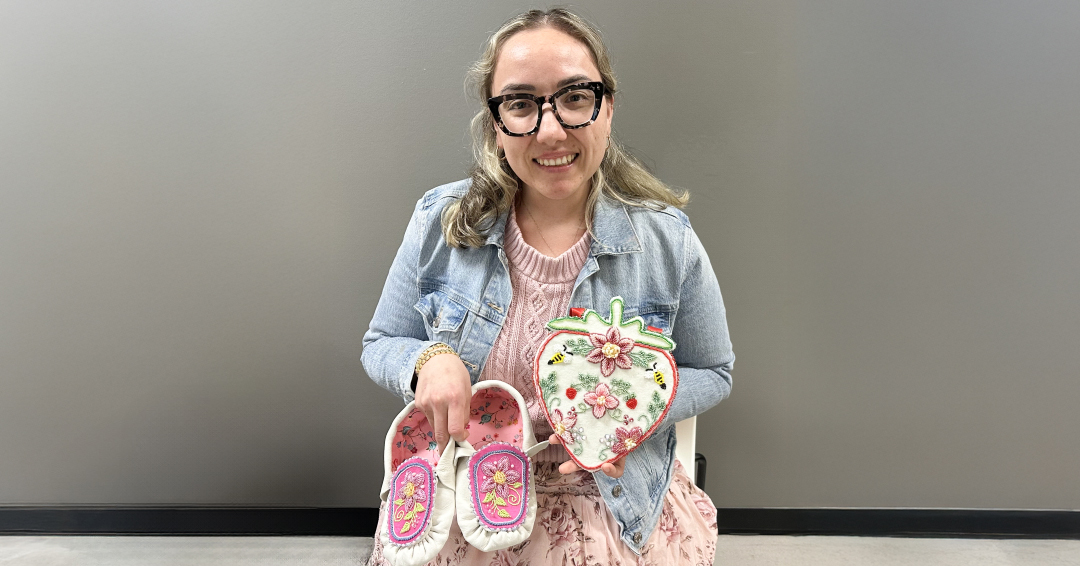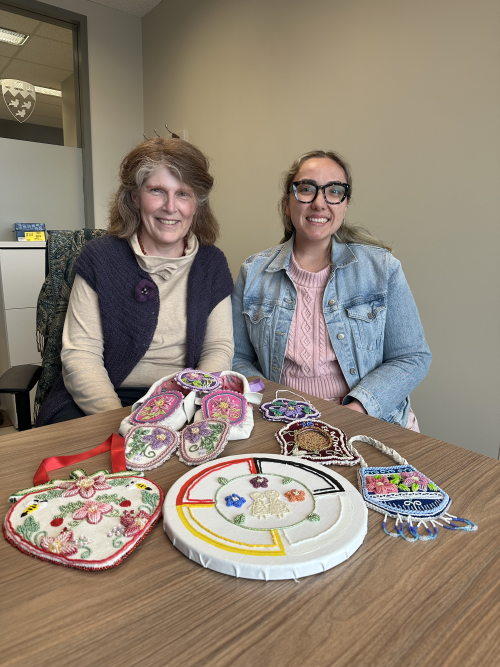
In a world where nurses must be both competent and compassionate, the integration of arts-based teaching strategies into graduate nursing education can help nurses build fundamental qualities of empathy, self-awareness, and imagination
 Heather Hart and Erin Patton
Heather Hart and Erin Patton
In the graduate course NUR2 608 Seminar in Nursing, an unexpected journey of cultural reconnection began for one Indigenous student through the simple yet profound act of beading. What started as an arts-based assignment quickly evolved into a transformative experience bridging academic learning with ancestral wisdom and self-discovery.
The art installation assignment was developed by course coordinator, Heather Hart, to give students the opportunity to express their understanding of Strengths-based Nursing and Healthcare through artistic expression. Rather than a conventional paper or presentation, students were invited to use artistic mediums such as visual arts, music, dance or storytelling to capture their key experiences and learning in the course. For many students, art can be a somewhat daunting departure from typical nursing coursework, but for primary care nurse practitioner student Erin Patton, the invitation to use art opened a door to personal discovery and meaning.
Having grown up in Kahnawake on the south shore of the St. Lawrence River, like many of her peers, Erin comes from a community that has experienced the historical disruptions of colonization, residential schools, and urban relocation. As a long-standing consequence of this oppression, many Mohawk youth grow up feeling detached from their culture, “I felt kind-of disconnected growing up, I didn’t speak the language and no one in my family beaded or practiced these kinds of crafts,” says Erin.
Haudenosaunee women have a long history with the craft of elaborate beading—a practice deeply embedded in Mohawk identity and storytelling. Mohawk beadwork specifically is raised and three dimensional, creating beautiful designs and pieces of art. Erin started with a beaded medicine wheel which she exhibited at the Art Exhibition at the end of the NUR2 608 course. As she beaded, she immersed herself in the rhythm and repetition of the craft which she experienced as both “therapeutic and a good way to unwind”. Each bead, each stitch, became a connection to the generations of women before her who had created functional pieces such as moccasins, jewelry, ornamentation and ceremonial pieces as expressions of love, care, and cultural continuity. “I consider it a real luxury to have, and be able to produce, these cultural pieces” reveals Erin.
The impact of this assignment went beyond fulfilling a course requirement—it was an opportunity to reclaim a traditional art form. Erin continues to bead and has created a number of pieces that express a deep connection to her culture and her roots. This story highlights the profound possibilities that emerge when academic learning is aligned with cultural and creative expression. In nursing education, where evidence-based practice and scientific rigour are essential, there is still ample room for the arts to serve as a bridge to deeper understanding and to other ways of knowing, which according to Prof. Hart, “are sometimes less valued and nurtured in academia”. Arts-based assignments encourage nursing students to explore the personal, cultural, and emotional dimensions of their work, offering pathways to insight and meaning that more conventional assignments may not achieve.
For teacher Heather Hart, “This experience with Erin, of seeing her embrace beadwork with such enthusiasm and pride, is a reminder that, as a teacher, I can never fully know how something I offer in class might resonate with a student, how it might lead to other growth or discovery. I think that is part of the mystery and richness of teaching.”
Erin Patton’s journey is a reminder of the healing power of creativity. In a world where nurses must be both competent and compassionate, the integration of arts-based teaching strategies into graduate nursing education can help nurses build fundamental qualities of empathy, self-awareness, and imagination. It also affirms that cultural identity is not something left at the classroom door—it is part of the fabric of who students are, and when it is welcomed, remarkable things can happen. For Heather Hart, this experience has reinforced her approach, “Erin’s beautiful work encourages me to trust in my work as a teacher and to continue to create opportunities in which students can express themselves in different ways”.


